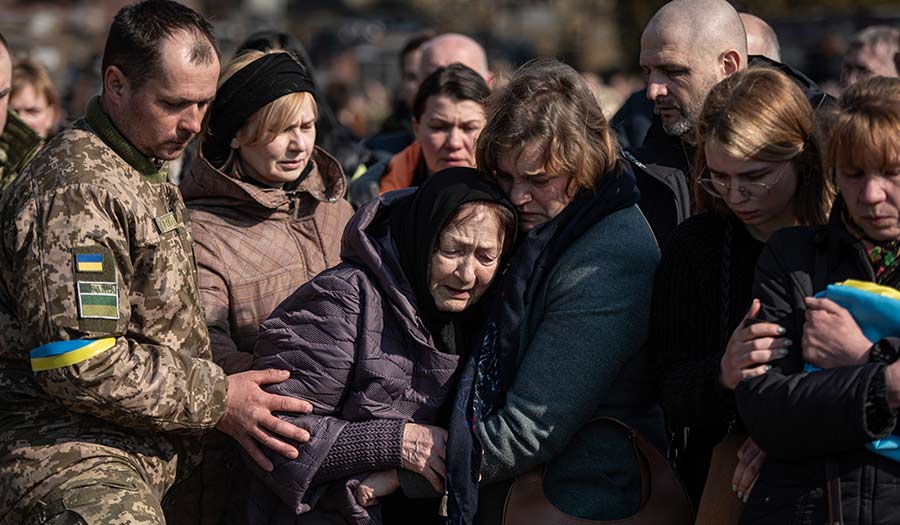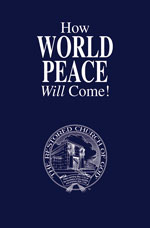 Alexey Furman/Getty Images
Alexey Furman/Getty Images
World News Desk
Learn the why behind the headlines.
Subscribe to the Real Truth for FREE news and analysis.
Subscribe NowRussia’s invasion of Ukraine has left tens of thousands dead, displaced millions and sown economic turmoil across the world in the 18 months since its launch on February 24, 2022.
Here are some details of the impact.
Death
The war has caused death on a level not seen in Europe since World War II.
More than 9,000 civilians had been recorded as killed and more than 16,000 injured by the end of July, according to the United Nations High Commissioner for Human Rights (OHCHR), which said it believed the actual figures were considerably higher.
The war has left nearly 500,000 troops either dead or injured, according to the New York Times.
The paper cited officials from the United States, which supports Ukraine, as saying as many as 120,000 Russian troops have been killed and 170,000 to 180,000 injured, with Ukraine’s military toll at 70,000 killed and 100,000 to 120,000 wounded.
Russian officials say U.S. estimates of Russian losses are far too high—and are propaganda. Russian Defense Minister Sergei Shoigu said on September 21 that 5,937 Russian soldiers had been killed since the start of the war. No further updates have been given since then and losses are a state secret.
Ukraine has not said how many of its soldiers have been killed and also says its military losses are a state secret as they affect battlefield tactics.
The conflict in eastern Ukraine began in 2014 after a pro-Russian president was toppled in Ukraine’s Maidan Revolution and Russia annexed Crimea, with Russian-backed forces fighting Ukraine’s armed forces.
About 14,000 people were killed there between 2014 and the end of 2021, according to the OHCHR, including 3,106 civilians.
Displacement
Since the 2022 invasion, millions of Ukrainians have been forced from their homes, the United Nations refugee agency has said. Ukraine has a population of more than 41 million.
An estimated 17.6 million people in Ukraine require urgent humanitarian support, including more than 5 million people internally displaced by the war, the UNHCR said.
There are over 5.9 million refugees from Ukraine recorded across Europe, according to the agency’s data.
Ukraine
Russia has taken 11 percent of Ukraine’s territory since the start of the war, an area equivalent to Massachusetts, New Hampshire and Connecticut combined, according to the Belfer Center at the Harvard Kennedy School.
When added to Crimea, which Russia annexed from Ukraine in 2014, Russia now controls about 17.5 percent of Ukraine, an area of about 41,000 square miles.
After pushing back Russian forces in 2022, it has failed to make major inroads against well-dug-in Russian troops since launching a new counteroffensive in early June.
Ukraine has lost a swathe of its coastline, its economy has been crippled and some cities have been turned into wastelands by the fighting.
Ukraine’s economy contracted by 30 percent in 2022 and is forecast to grow by of 1 to 3 percent this year, according to the International Monetary Fund.
It is unclear how much Ukraine has spent on the fighting.
Russia
Russia’s expenditure on the war is a state secret, but it coincides with a major shock to the Russian economy from the toughest-ever Western sanctions imposed after the invasion.
The economy defied early expectations for a double-digit contraction in 2022, but a return to prosperity remains a long way off as the government directs more spending towards the military.
Russia’s economy will grow 1.5 percent this year, according to the International Monetary Fund, after a contraction of 2.1 percent in 2022.
“In the medium term, the Russian economy will be hampered by the departure of multinationals, the loss of human capital, its disconnection from global financial markets, a reduction in its policy buffers,” IMF spokeswoman Julie Kozack said last month.
“And therefore, we do expect over the medium term that output in Russia will be 7 percent lower than the pre-war forecast.”
Russia has doubled its 2023 defense spending target to more than $100 billion—a third of all public expenditure—a government document reviewed by Reuters showed, as the costs of the war in Ukraine spiral and place growing strain on Moscow’s finances.
As Russia’s military spending soars and sanctions squeeze its energy revenues, Moscow faces a battle to keep its budget deficit in check.
Russia has lost a major chunk of the European gas market but has been able to keep selling its oil to global markets, although the United States, Europe and other powers have limited or ended their purchases.
It has been excluded from Western financial markets, most of its oligarchs are sanctioned, and it is experiencing problems sourcing some items such as microchips.
CIA Director William Burns said earlier this year that Mr. Putin risked turning Russia into “an economic colony of China over time.”
Russia has defaulted on its foreign bonds for the first time since the calamitous months following the 1917 Bolshevik revolution.
Prices
The invasion and Western sanctions on Russia led to steep rises in the prices of fertilizer, wheat, metals and energy, fueling an inflationary wave and a global food crisis.
Russia is the world’s second-largest oil exporter after Saudi Arabia and the world’s biggest exporter of natural gas, wheat, nitrogen fertilizer and palladium.
Shortly after Russia’s invasion of Ukraine, international oil prices spiked to their highest levels since the records of 2008.
Western Weapons
Since the invasion, the United States has committed more than $43 billion in security assistance to Ukraine, including stinger anti-aircraft systems, Javelin anti-armor systems, 155mm Howitzers and equipment to protect against chemical, biological, radiological and nuclear attack.
The biggest overall supporters of Ukraine in nominal terms are the United States, the European Union, Britain, Germany and Japan, according to The Kiel Institute for the World Economy.
Russia says the West’s weapons supplies are escalating the war.
This report contains information from Reuters.
More on Related Topics:
- Ukraine’s Surprise Cross-border Incursion Seen as a Tactical Reply to Russia’s Grinding Gains
- F-16s Have Arrived to Help Ukraine Fight Russia. What Is Their Possible Impact?
- Ukraine Starts EU Membership Talks in Midst of War
- Russia Broadens Tactical Nuclear Weapons Drills
- Berlin Lets Ukraine Use German Weapons Against Targets in Russia After the U.S. Also Eases Stance



